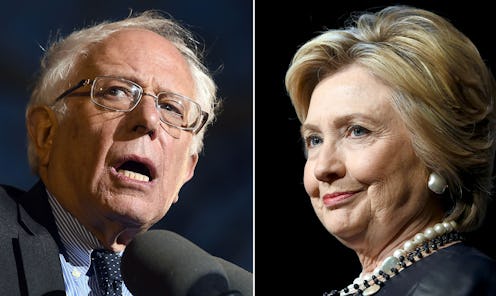News
What Delegate Percentage Must Each Democrat Win?
In a recent interview with CNN's Jake Tapper on Sunday, Hillary Clinton expressed her confidence that she will reach the number of delegates required for the Democratic nomination. Unlike the Republican candidates, who are looking closer and closer to a contested convention, there are only two candidates vying for delegates on the Democratic side — Clinton and Bernie Sanders. The Vermont senator has won eight of the nine last states, but percentages play a huge role at this point, particularly since most states are not winner-take-all and delegates are distributed proportionally, meaning based on the percentage of votes each candidate receives. At this point, New York is the next big state to vote, carrying 247 delegates on April 19. So what is the percentage of delegates Clinton and Sanders respectively need from the next 16 states, Guam, the U.S. Virgin Islands, Puerto Rico, and Washington D.C. to secure the nomination?
Well, ruling out superdelegates, who can alter their endorsement at the Democratic National Convention, the current numbers after 34 rounds of voting look as follows: Clinton has 1,287 pledged delegates to Sanders' 1,037. Either candidate cannot secure the Democratic presidential nomination without the required number of 2,383 delegates. Up for grabs still is 1,941 delegates, with the aforementioned 247 allocated to New York, 95 in Maryland, 189 in Pennsylvania, 83 in Indiana, 475 in California, and 126 in New Jersey, to name some of the heavy ones.
These numbers indicate that Clinton still requires 1,096 delegates to Sanders' 1,346. Although Clinton is ahead by exactly 250 pledged delegates, if each can maintain a strong showing, there is a chance for either candidate to reach that mythical 2,383 delegates. In order to stay consistently on track, Sanders would need just over 50 percent of New York's Democratic vote, equating to about 125 delegates, whereas Clinton would need between 49 and 50 percent of the vote to achieve at least 122 delegates, which would keep her up to speed.
The lowest percentages of votes necessary for Clinton or Sanders to win the nomination is 48.8 percent overall for Clinton and 50.8 percent for Sanders. This will obviously vary if either candidate scores particularly high or low in any major state, but as it stands presently, the average of the percentages needed in each of the upcoming states and territories amounts to 48.8 versus 50.8, which is, frankly, pretty close. These numbers, however, do not account for demographics in the upcoming states. Clinton tends to do better with blacks, Latinos, senior citizens, and moderate-to-conservative Democrats. Sanders' strength is with white voters, as well as young, liberal, and working-class Democrats.
Many say Sanders cannot take the nomination — despite his recent wins — because simple mathematics prevents it. According to the U.S. Census Bureau's 2014 statistics, New York, for example, is 70 percent white, between 15 and 20 percent black, close to 20 percent Latino, and just under 15 percent of residents are over 65 years of age. This means, according to expected trends, Sanders could gain a lead if the Democratic base leans liberally and working class voters show up to the polls in just over a week.
It looks like the next 20 primary elections are going to make or break Clinton's confidence. Whether or not Sanders can keep up his momentum and score a percentage of over 50.8 will begin to unfold in New York on April 19, so keep an eye out for the Empire State's big day.
